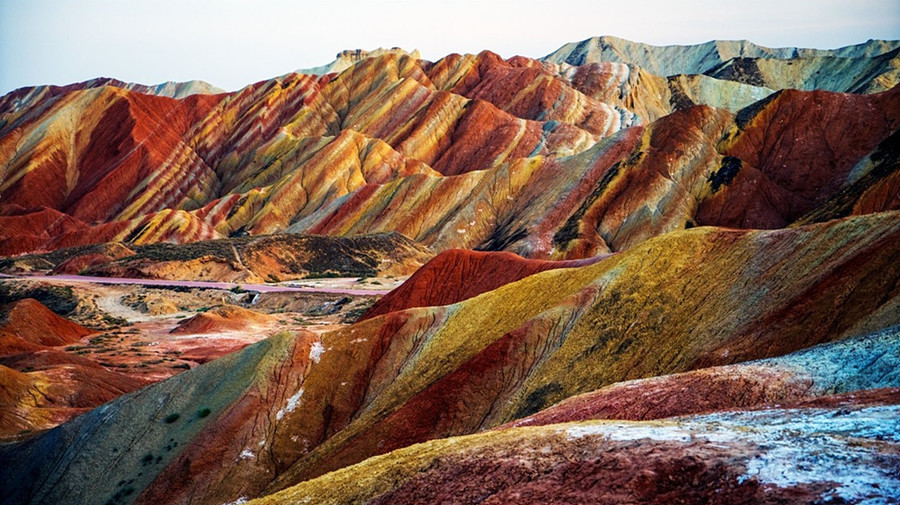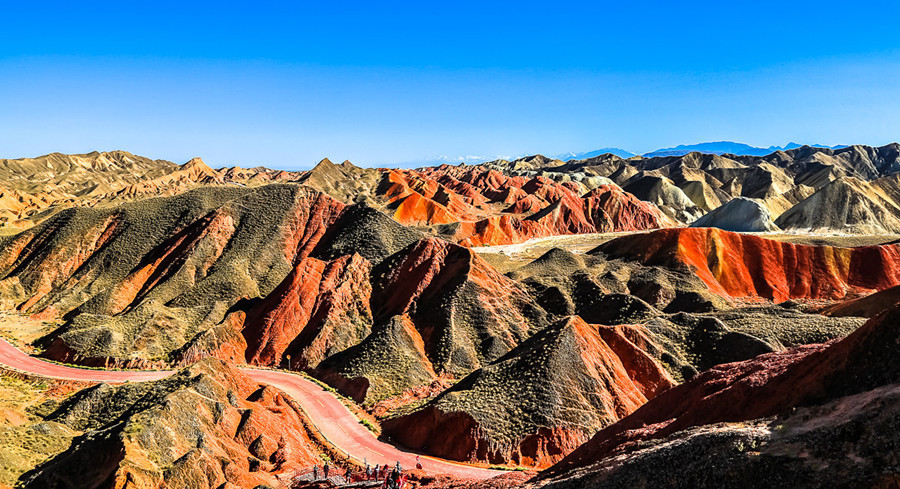
Zhangye Danxia Landform Geopark
Zhangye Danxia National Geological Park (张掖丹霞地质公园), located in Zhangye City (张掖市), Gansu Province (甘肃省), China, is a vast area of unique geological formations. Situated along the northern slope of the Qilian Mountains (祁连山), the park stretches over 1,289.71 square kilometers. It features dramatic landscapes formed by various natural forces, and is recognized as one of the world’s most spectacular geological parks.
The park’s geographical coordinates are 99°16′12″~100°07′37″E and 38°40′52″~39°03′36″N. The boundaries of the park are marked by various administrative divisions: the western boundary follows the provincial boundary between Gansu Province and Qinghai Province; the eastern boundary follows the original national geopark boundaries; the southeastern boundary is marked by the Qilian Mountain National Nature Reserve (祁连山国家级自然保护区); and the northern and southern boundaries follow geographical borders.
Climate and Geography
Geographical Environment
Zhangye Danxia National Geological Park is located on the middle section of the northern slope of the Qilian Mountains. The region’s terrain features significant elevation variations, with the southwestern and northern parts being higher and the central area being lower. The park is rich in varied landforms, from mountain ridges to river valleys, shaped over millennia by erosion, water flow, and climatic factors.
Geology
The geological formations in the park date back to the Mesozoic and Cenozoic eras, primarily involving red sandstone and gravel layers formed through sedimentation. The Himalayan orogeny (喜马拉雅造山运动) played a pivotal role in the tilt and folding of rock layers. During the late Oligocene, the region experienced significant geological activity, with the northward subduction of the ancient Qilian Ocean (祁连古洋) which left behind a distinctive geological record.
The park’s terrain consists mainly of cutting high mountains, low and middle hills, and river valleys, particularly along the Heihe River (黑河) and its tributaries. These formations showcase the unique Danxia landform (丹霞地貌) and the colorful hills (彩色丘陵) that are characteristic of the region.

Main Attractions
1. Colorful Hills Scenic Area (彩色丘陵景区)
The Colorful Hills are a stunning feature of Zhangye Danxia, located in the northeastern part of the park. They are composed of sedimentary rock layers dating back to the Early Cretaceous (约1.37亿~1.96亿年前). The hills’ vibrant colors, including reds, yellows, greens, and purples, are a result of varying mineral content. These hills not only represent the changes in the climate but also reflect the evolution of the landscape over millions of years.
2. Binggou Danxia Scenic Area (冰沟丹霞景区)
Located in Kangle Township (康乐乡), this area is renowned for its Northern Danxia landforms. The area showcases a series of red sandstone layers, ranging from young gully formations (巷谷) to mature rock walls (岩墙) and remaining peaks (残峰). The palace-like formations and pillar-like structures here are unique to Zhangye and have been described as “windows” and “palaces” carved by nature.
3. Chinese Yugu Ethnic Culture Corridor Scenic Area (中华裕固风情走廊景区)
This corridor, located in the center of the park, combines geological relics, glaciers, snow-capped mountains, and the Yugu ethnic culture (裕固族). The region provides a unique fusion of natural wonders and ethnic traditions. The area spans approximately 80 kilometers and highlights the transition from the Qilian Mountains to the Hexi Corridor (河西走廊). It serves as a living museum of geology and local culture, with ancient marine fossils and cultural heritage.
4. Jiugou Spring (九个泉)
Located in the western part of the park, Jiugou Spring is a historic geological site. The area is significant for its greenstone formations (蛇绿岩), which provide critical evidence for early Paleozoic (古生代) tectonic movements. The site offers a combination of rare wildlife and geological formations, contributing to its status as a natural and scientific wonder.
Social and Cultural Value
Zhangye Danxia’s expansive and colorful landforms have high scientific and aesthetic value. Its varied and rich landscape is one of the largest and most well-preserved Danxia landforms in China. According to Professor Huang Jin (黄进), an authority on Danxia landforms, Zhangye’s Danxia is “the most beautiful and extensive in China,” with its colorful hills and palace-style Danxia formations earning global recognition.
Zhangye Danxia has been honored as one of the world’s 10 most magical geographical wonders and is known for its vibrant and spectacular landforms.

Honors and Achievements
-
In 2005, the Zhangye Danxia landform was officially recognized as a provincial-level geological park.
-
In 2011, the park was classified as a 4A-level tourist attraction by the National Tourism Administration of China.
-
In 2020, the park was approved as a UNESCO Global Geopark, marking a significant milestone in its international recognition.
-
It has also been featured in the National Geographic Magazine as one of the top 10 geographical wonders globally.
Travel Information
Opening Hours
-
Summer: 7:00 AM – 6:00 PM
-
Winter: 7:30 AM – 5:00 PM
-
Special Open Hours: May 5 – August 31 and October 1-7, 5:30 AM – 7:00 PM
Ticket Information
-
Qicai Danxia (Seven-colored Danxia): 74 RMB (includes 54 RMB entry + 20 RMB for electric vehicle)
-
Binggou Danxia: 60 RMB (includes 40 RMB entry + 20 RMB for electric vehicle)
-
Free Entry: Children under 1.2 meters, seniors over 70 with ID

Transportation
-
Air Travel: Zhangye Ganzhou Airport (张掖甘州机场), also known as Zhangye Civil and Military Airport (YZY), offers flights to Lanzhou and Xi’an. Alternatively, you can fly to Lanzhou or Xining, then take a high-speed train to Zhangye.
-
Rail Travel: Zhangye Railway Station and Zhangye West Station (High-Speed) serve passengers coming from Urumqi, Xi’an, Lanzhou, and other cities.
-
By Bus: From Zhangye Railway Station or Zhangye West Station, you can take buses that go to the park. Travel times are about 30 minutes, with tickets costing 10 RMB one way.
-
Self-Driving: You can take the Sunan Highway and drive to the Zhangye Danxia park. It’s about a 49 km drive from the highway exit.
Rent a Car:
-
Bus: Around 800 RMB per vehicle per day
-
Taxi: One-way fare is approximately 100 RMB; round-trip fare is around 160 RMB
This park offers a chance to explore one of the most exceptional geological sites in China, showcasing millions of years of natural history and breathtaking views.













